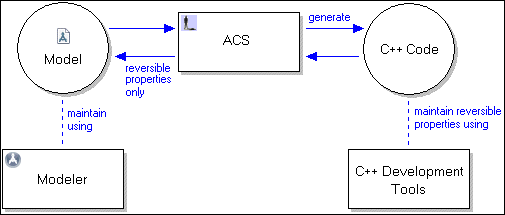Overview of generating C++ code (C++ code)
ACS helps you develop your application by generating the C++ code files required to implement a Class Model defined in Modeler.

Using Modeler you can quickly define your system in an environment that allows you to view the struct structure as a whole. After describing the behavior of your structs using State Diagrams, you can use ACS to generate the code required to implement those State Diagrams. Thereafter, you can use ACS to update the C code with any changes made to the Class model in Modeler.
After you have set up ACS, it works in the background and you do not have to interact with it. ACS monitors a model and its generated code for changes:
• If ACS detects a change made by you in the model that affects the code, ACS can automatically generate the relevant code files.
• If ACS detects a change to an operation body, an EAB action or EAB guard condition in the code, ACS can automatically reverse engineer the changed text to the model.
ACS uses a Code Generator DLL to generate the code. You select the required ACS Code Generator DLL to use from the Launch ACS/TDK dialog. For more information about the provided ACS Code Generator DLLs, see ACS Code Generator DLLs.
You can customize how code is generated by customizing the supplied ACS Code Generator DLLs. |
You can model C++ specific information in the model through the C++ Profile package.
If you are learning to use Modeler and ACS, you may find the Modeler tutorials useful. For information about downloading and opening the PTC Modeler tutorials, see PTC Modeler tutorials.
ACS can generate C++ code files for simulating your system in Modeler. For more information about system simulation, see Introduction to system generation and simulation (system simulation).
For generic information about using ACS, including deciding on a strategy for reverse engineering reversible properties, see Overview of Shadow.
For information about customizing ACS Code Generator DLLs through TDK, see (link works only if TDK is installed).